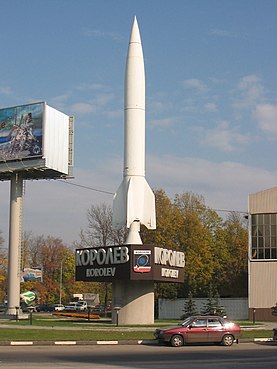R-2 (missile)
| R-2 (missile) | |
|---|---|
| General Information | |
| Type | Short-range missile |
| Local name | R-2 |
| NATO designation | SS-2 Sibling |
| Country of origin |
|
| Manufacturer | KB Korolyov |
| development | 1949 |
| Commissioning | 1951 |
| Working time | 1952-53 |
| Technical specifications | |
| length | 19.65 m |
| diameter | 1,650 mm |
| Combat weight | approx.20,000 kg |
First stage drive |
RD-101 liquid rocket engine |
| Range | 600 km |
| Furnishing | |
| Warhead | 1 high explosive warhead |
| Lists on the subject | |
The R-2 ( NATO code name SS-2 Sibling) was a liquid-powered Soviet short-range missile developed in the late 1940s and built in the early 1950s under the direction of chief designer Sergei Pavlovich Korolev . Its development was based on the German A4 and used knowledge gained during the construction of the Soviet R-1 missile , a direct copy of the A4. It was the first of its kind to have a warhead that was separated from the propulsion system and that was detached from the body of the rocket before it re-entered the earth's atmosphere . Their impact accuracy was improved by a radio control system for lateral correction to a scattering circle radius of 1250 m. The centerpiece, the rocket motor RD-101 with 340 kN thrust, was developed under the direction of Valentin Gluschko on the basis of the replica A4 engine RD-100 for the R-1. German specialists like Helmut Gröttrup had an important influence with the sketch project G-1 (R-10). Ethanol with 8% water content served as fuel and deep-frozen liquid oxygen was still used as an oxidizer . The tanks were lengthened compared to the R-1 and the fuel tank was designed for the first time as a supporting component for the rocket, which significantly increased the range of the rocket.
The first test flight took place in October 1950, but the first 12 launches failed until December 1950 due to problems with the control system or the destruction of the separated warhead due to the effects of heat when it re-entered the atmosphere. It was only when the second series was tested in July 1951 that 12 of the 13 missiles launched reached the target area at a distance of 553 km. In November 1951 the development was finished, whereupon a larger number of rockets was put into service until 1953. Although the rocket was more powerful than its predecessor R-1, it became obsolete within a short time , since it took six hours and about twenty vehicles to launch an R-2 alone. Another shortcoming was the flight control system that was still used. From 1956 it was supplemented by its successor, the R-5 , and decommissioned in 1962.
A modification, the R-2A, was used for geophysical surveys; with it, like with the R-1, dogs were transported into space.
The R-2 was rebuilt in China as Dongfeng 1 in accordance with a license agreement dated December 6, 1957 .
Web links
- R-2 in the Encyclopedia Astronautica (English)
- http://www.russianspaceweb.com/r2.html (English)
Individual evidence
- ^ Mark Wade: G-1 (alternative name R-10). In: Encyclopedia Astronautica. Retrieved June 19, 2020 (English).
- ^ A b Matthias Uhl : Stalin's V-2. The technology transfer of German radio controlled weapons technology to the USSR and the development of the Soviet missile industry from 1945 to 1959 . Dissertation with reproduction of many original documents. Bernard & Graefe Verlag, Bonn 2001, ISBN 978-3-7637-6214-9 (304 pages).

